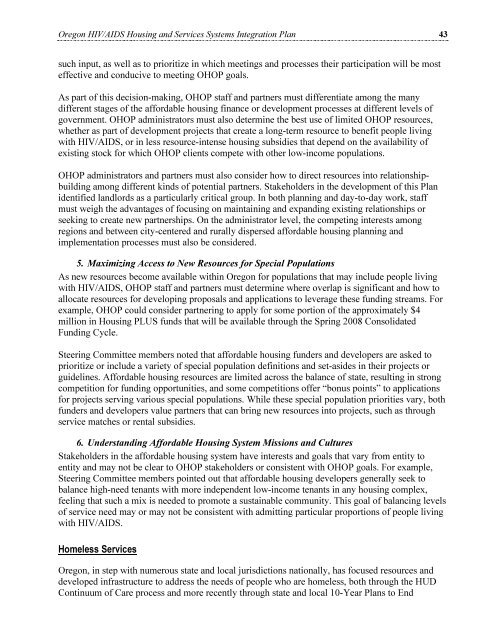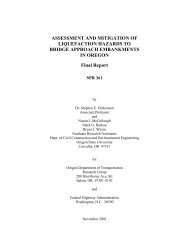Oregon Balance of State HIV/AIDS Housing & Services Systems ...
Oregon Balance of State HIV/AIDS Housing & Services Systems ...
Oregon Balance of State HIV/AIDS Housing & Services Systems ...
You also want an ePaper? Increase the reach of your titles
YUMPU automatically turns print PDFs into web optimized ePapers that Google loves.
<strong>Oregon</strong> <strong>HIV</strong>/<strong>AIDS</strong> <strong>Housing</strong> and <strong>Services</strong> <strong>Systems</strong> Integration Plan 43<br />
such input, as well as to prioritize in which meetings and processes their participation will be most<br />
effective and conducive to meeting OHOP goals.<br />
As part <strong>of</strong> this decision-making, OHOP staff and partners must differentiate among the many<br />
different stages <strong>of</strong> the affordable housing finance or development processes at different levels <strong>of</strong><br />
government. OHOP administrators must also determine the best use <strong>of</strong> limited OHOP resources,<br />
whether as part <strong>of</strong> development projects that create a long-term resource to benefit people living<br />
with <strong>HIV</strong>/<strong>AIDS</strong>, or in less resource-intense housing subsidies that depend on the availability <strong>of</strong><br />
existing stock for which OHOP clients compete with other low-income populations.<br />
OHOP administrators and partners must also consider how to direct resources into relationshipbuilding<br />
among different kinds <strong>of</strong> potential partners. Stakeholders in the development <strong>of</strong> this Plan<br />
identified landlords as a particularly critical group. In both planning and day-to-day work, staff<br />
must weigh the advantages <strong>of</strong> focusing on maintaining and expanding existing relationships or<br />
seeking to create new partnerships. On the administrator level, the competing interests among<br />
regions and between city-centered and rurally dispersed affordable housing planning and<br />
implementation processes must also be considered.<br />
5. Maximizing Access to New Resources for Special Populations<br />
As new resources become available within <strong>Oregon</strong> for populations that may include people living<br />
with <strong>HIV</strong>/<strong>AIDS</strong>, OHOP staff and partners must determine where overlap is significant and how to<br />
allocate resources for developing proposals and applications to leverage these funding streams. For<br />
example, OHOP could consider partnering to apply for some portion <strong>of</strong> the approximately $4<br />
million in <strong>Housing</strong> PLUS funds that will be available through the Spring 2008 Consolidated<br />
Funding Cycle.<br />
Steering Committee members noted that affordable housing funders and developers are asked to<br />
prioritize or include a variety <strong>of</strong> special population definitions and set-asides in their projects or<br />
guidelines. Affordable housing resources are limited across the balance <strong>of</strong> state, resulting in strong<br />
competition for funding opportunities, and some competitions <strong>of</strong>fer “bonus points” to applications<br />
for projects serving various special populations. While these special population priorities vary, both<br />
funders and developers value partners that can bring new resources into projects, such as through<br />
service matches or rental subsidies.<br />
6. Understanding Affordable <strong>Housing</strong> System Missions and Cultures<br />
Stakeholders in the affordable housing system have interests and goals that vary from entity to<br />
entity and may not be clear to OHOP stakeholders or consistent with OHOP goals. For example,<br />
Steering Committee members pointed out that affordable housing developers generally seek to<br />
balance high-need tenants with more independent low-income tenants in any housing complex,<br />
feeling that such a mix is needed to promote a sustainable community. This goal <strong>of</strong> balancing levels<br />
<strong>of</strong> service need may or may not be consistent with admitting particular proportions <strong>of</strong> people living<br />
with <strong>HIV</strong>/<strong>AIDS</strong>.<br />
Homeless <strong>Services</strong><br />
<strong>Oregon</strong>, in step with numerous state and local jurisdictions nationally, has focused resources and<br />
developed infrastructure to address the needs <strong>of</strong> people who are homeless, both through the HUD<br />
Continuum <strong>of</strong> Care process and more recently through state and local 10-Year Plans to End

















